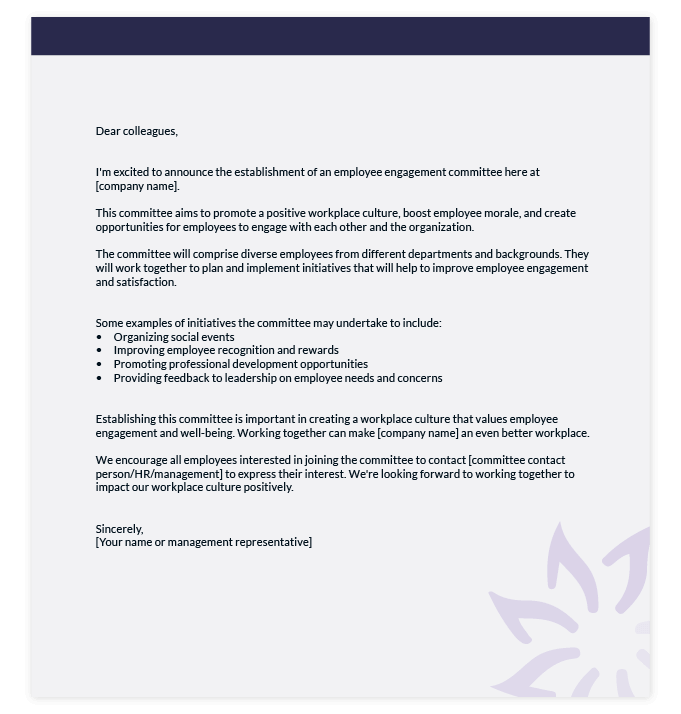How To Form Your Employee Engagement Committee?

If your goal is to promote your organization's growth, investing in your employees is important. You must provide opportunities for your employees to engage, participate and offer feedback. Employees who do that are more likely to do quality work and foster a healthy work atmosphere. One effective way to achieve this is to form an employee engagement committee.
What Is An Employee Engagement Committee?
An employee engagement committee is a group of employees who come together voluntarily to:
-
plan and implement activities designed to engage and motivate employees.
-
create a positive and productive workplace culture.
-
work on strengthening the employer's relationship with its employees.
Read our blog on: Importance Of Employer Employee Relationship In Companies
Apart from these, its responsibilities include:
- making employees' voices heard by their leaders.
- celebrating employee accomplishments,
- fostering work-life balance, and
- planning team-building events, among other things.
Read our blog on: 38 Quick and Easy Team Building Activities Your Employees Will Love (+How to Play)
Why Do You Need An Employee Engagement Committee?

Employee engagement committees are beneficial for a variety of reasons. Let's look at some of them, which are briefly detailed below.
1. Improves job satisfaction
One of the primary objectives of an employee engagement committee is to create a fun work culture. It includes organizing events and activities that are beneficial to the organization. The ultimate goal is to foster employee camaraderie. With proper networking, they look out for exchanging ideas within the organization.
Moreover, it is a channel for improved communication between management and employees. This results in greater transparency.
Furthermore, it coordinates training and mentorship opportunities for employees. Employees who feel they are learning and growing have greater job satisfaction.
2. Encourages new ideas
Employee engagement efforts may be haphazard in the absence of a committee. A successful committee streamlines the process and makes it more routine. It generates fresh ideas of engagement while prioritizing the emotional commitment of the workforce. Moreover, these committees thrive on innovative ways that boost an organization's engagement efforts and keep the morale high of the employees.
Read our blog on: 5 Incredible Techniques To Develop An Innovation Culture
3. Gives everyone a voice
Recognizing the importance of employee voice is vital to facilitate prolonged and sustainable company growth. Encouraging an open, honest, and transparent environment within your business is a prerequisite to creating a more positive and productive workplace. Champion your team, and they will champion you. Will Murray, CEO of Oak Engage
Employee engagement committees empower your employees to express themselves openly. They provide a forum for employees to share their ideas and concerns. For example, they encourage staff to make suggestions to increase team productivity. Such initiatives, of course, contribute to the organization's overall improvement.
4. Encourages timely recognition and appreciation

It encourages managers to recognize and appreciate employees' good work and achievements. This could be through simple gestures such as a thank-you note or social recognition in a meeting. Nonetheless, they make sure that it’s timely and consistent.
And you can do it with the assistance of Vantage Circle's AI-powered recognition platform. With the platform, you can set the desired budget for your employees and assign specific roles within the team. Once everything is set, you can start appreciating your coworkers while incentivizing the awards with points.

5. Promote problem-solving collaboration
The employee engagement committee encourages team members to collaborate to solve problems. They give employees the resources and tools they need to solve problems together. Resources include conference rooms, technological aid, and access to information and data.
At the same time, they acknowledge individual contributions to the problem-solving process. It also celebrates the committee's triumphs and accomplishments.
6. Address the challenges of today's workplace
Remote and hybrid workers have a difficult time engaging. In comparison, physical employee engagement is simpler but has become more limited in most workplaces. We can see that, employee camaraderie and culture find it difficult to develop naturally in physical workplaces.
An employee engagement committee can tackle these issues. How? By encouraging employees to stay in touch. The committee holds frequent team-building activities to foster collaboration, improve team dynamics, and build good working relationships.
7. Works on employee development possibilities
The committee can also provide opportunities for employees to learn new skills. They can help to:
-
identify areas where employees may need additional training or support,
-
work with the organization's HR department to develop relevant programs or initiatives and,
-
encourage employees to take on leadership qualities.
All these efforts help to promote a feeling of belonging and dedication to the firm.
How To Establish Your Employee Engagement Committee

1. Notify your team and invite volunteers

Explain what an employee engagement committee is and why you're forming one. Assist your team in understanding what topics they can discuss with committee members. Using your company's HR platforms, you can notify your organization about your plans.
Here's an example of how you could introduce the establishment of such a committee to your organization:

2. Seek diverse, cross-functional volunteers
Identify team members who may be interested in participating in the committee. Filter down candidates with various backgrounds, ages, corporate roles, races, and genders. It would be best if you also looked for various perspectives and points of view.
3. Have clear, written goals and action plans

Determine the role of each committee member and how you will prepare reports of actions. Establish your mission and vision and define goals to guide the members' work. At some organizations, HR is in charge of this committee. Still, in others, committee members may report directly to the CEO. Determine how you will put this in place in your organization.
4. Make a budget
Establishing a budget will give you a clear understanding of the things that the committee can cover in the long run. So, make a budget for special events, programs, and meetings. Even a small budget can allow the committee to bring in coffee and dessert to boost morale.
5. Communicate with the larger organization
Inform the organization of the committee's activities and progress regularly. It will serve to raise awareness and support for the committee's efforts. Also, ensure that everyone understands the committee's goals and objectives.
6. Schedule meetings on time
Determine how frequently your culture committee should meet and plan accordingly. Build up forums for group interactions. It would help in sharing ideas between sessions, ensuring the progress of your objectives.
7. Take some power into your committee
An employee engagement committee should have enough power to carry out its responsibilities. It should include the ability to influence decision-making in your employee engagement initiatives. Also, it should be able to divide resources and manage budgets for your programs.
8. Create a strong brand for your employee engagement committee
Branding your employee engagement committee is an excellent idea. Branding helps in increasing awareness of the committee's activities. Here are some tips for branding your employee engagement committee:
- Choose a name
Pick the right employee engagement committee name. The name should be easy to remember, catchy, and express the purpose and goals of the committee.
- Make a logo
Create a visually appealing logo for your committee. The logo should be able to convey your goals and objectives. It must meet the branding standards of the organization as well.
- Create a tagline
Create a tagline that clearly expresses the committee's purpose and goals. "Empowering Workers to Build a Better Workplace," for example.
- Make use of social media
Promote the committee and its operations through social media. Establish a committee Facebook page, Twitter account, or LinkedIn group. You must use these media to share updates, news, and events.
- Create marketing materials
Create marketing materials to promote the committee and its activities. For example, posters, flyers, and pamphlets. Make it consistent and identifiable by using the committee's logo and tagline.
- Organize events
Organize promotional events for your activities. You can launch a party or a town hall meeting. These events are sure to increase excitement while communicating your mission and aims.
Considering these factors, you can choose the best members for your employee engagement committee. It would ensure that the committee is capable of impacting employee engagement significantly.
How Do You Select The Employee Engagement Committee Members?

Choosing the right members for your committee is critical to the committee's success. Here are a few things to think about while choosing your members:
1. Define the committee's purpose and scope
Before selecting members, determine the committee's objective and scope. This will help you figure out the skills and expertise that you need on the committee.
2. Look for diversity

Choose members from various departments, functions, and levels within the business. It ensures that the committee represents a diverse range of viewpoints and experiences. That will lead to more creative and effective problem-solving methods.
Read our blog on: Diversity and Inclusion in the Workplace: A Complete Guide
The committee should include senior managers and high-performing employees. A 50-50 distribution is recommended. Furthermore, to ensure consistency, consider evolving your committee. Create "**term restrictions**" for two years, with half the staff rotating yearly.
3. Consider their interest
Find the appropriate candidate based on their passion for participating and committee service. Ensure they do not regard their membership as "just another thing to do." They should be active and available, attend committee meetings and provide suggestions on time.
4. Consider their expertise and skills
Seek members with relevant skills and knowledge that match the committee's goals and objectives.
Say, if you want to improve workplace communication, look for members who are excellent communicators.
Balance committee members' workload and availability: Make sure to balance committee members' workload and availability. Avoid overburdening a small group of employees with too many duties.
5. Evaluate and finalize the selection
Once you've found suitable members, go over their qualifications and make your decision. Ensure to communicate the purpose and responsibilities of the committee to the selected members.
FAQs- Employee Engagement Committee

1. How frequently does the employee engagement committee hold a meeting?
Employee engagement committee meetings may vary in frequency. However, they are usually held monthly or quarterly.
2. What metrics do employee engagement committees use to assess performance?
They use employee engagement surveys, feedback, and engagement metrics such as employee turnover rates.
Read our blog on: 5 Easy And Cost-Effective Ways to Reduce Employee Turnover
3. How can employees offer suggestions or feedback to the employee engagement committee?
For feedback and suggestions, employees can use questionnaires or suggestion boxes. Or they can directly speak to a committee member.
4. How does the committee ensure the inclusiveness and diversity of its initiatives?
Having members from various backgrounds can ensure that it is inclusive and diverse. But, it is equally important to include their action plans and opinions in committee decisions.
5. Why join an employee engagement committee?
Joining an employee engagement committee is a great way to have a say in creating the best workplace culture. It's a chance to connect with colleagues from all levels of the organization. It is a great way to collaborate and learn from others. It can also boost your portfolio and showcase your leadership and teamwork skills. Overall, it's an excellent opportunity to make a difference in your workplace.

















